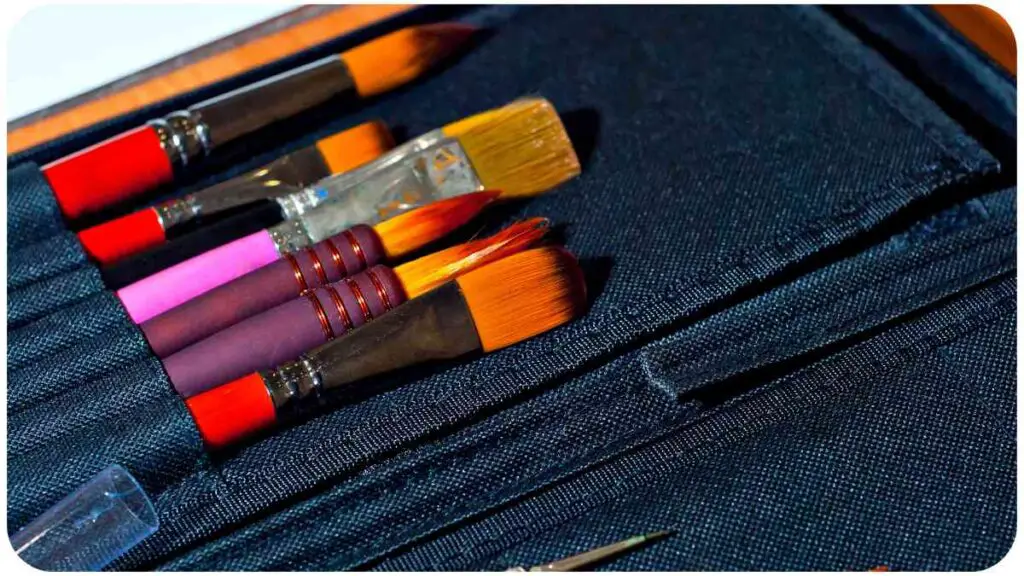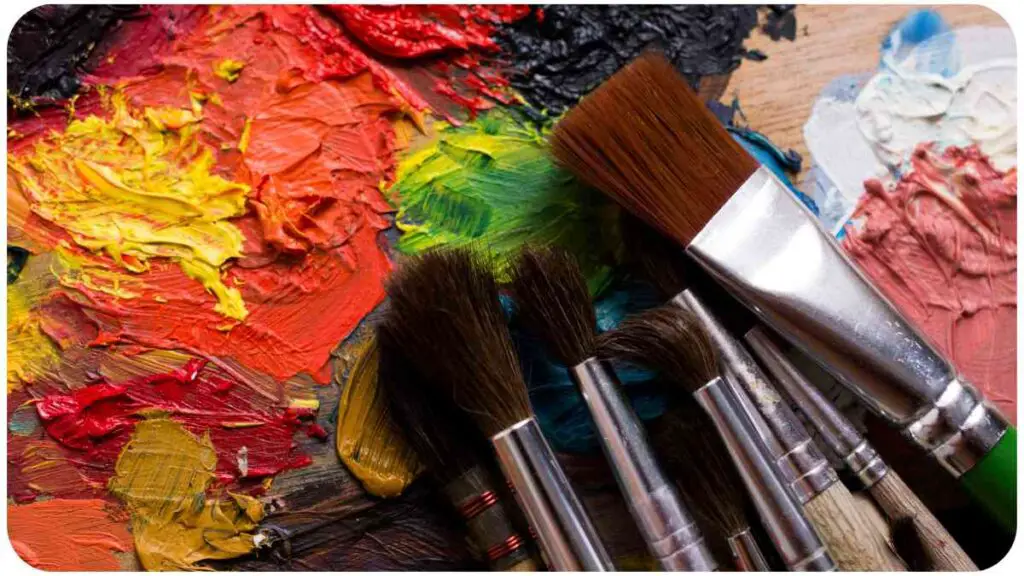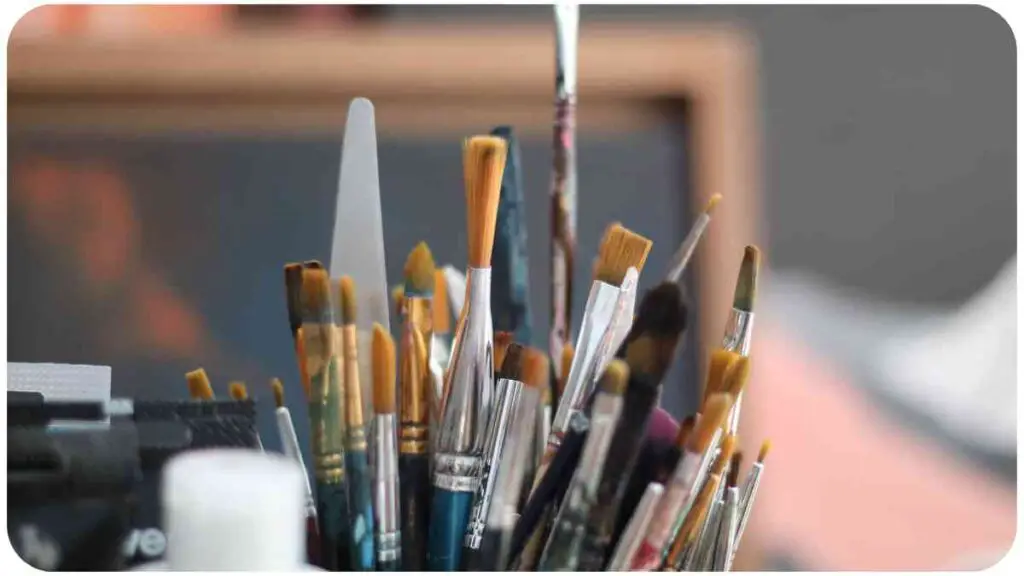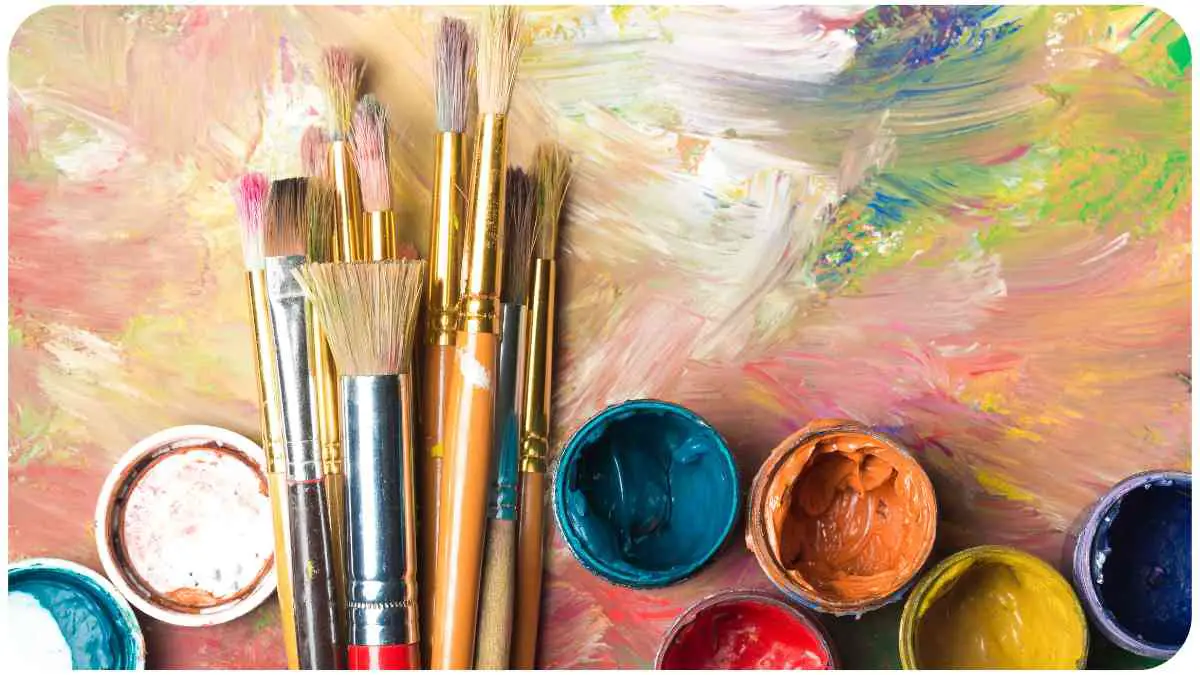Selecting the appropriate brush is a crucial aspect of any painting endeavor. The right brush can significantly impact the outcome of your artwork, influencing texture, stroke quality, and overall visual appeal.
In this comprehensive guide, we’ll explore the intricacies of choosing the perfect brush for your painting needs, delving into brush types, shapes, sizes, bristle materials, and more.
| Takeaway |
|---|
| Choosing the right paintbrush involves considerations such as type, shape, and bristle material. |
| Natural bristle brushes are ideal for oil painting, while synthetic brushes work well with acrylics. |
| Different brush shapes, like round, flat, filbert, angular, and fan, serve specific artistic purposes. |
| Proper brush maintenance, including cleaning and storage, is crucial for extending their lifespan. |
| Famous painters like Van Gogh and O’Keeffe had distinct preferences for brush types in their artworks. |
| Budget-friendly brush options and DIY solutions provide alternatives for artists on a tight budget. |
| Experimenting with various brushes and learning from expert recommendations enhances artistic expression. |
| FAQs address common queries, covering factors in choosing brushes, cleaning, storage, and more. |
| Further reading resources offer in-depth guides on paintbrush selection for continuous learning. |
2. Understanding Brush Types
2.1 Natural Bristle Brushes
| Brush Type | Characteristics | Best For |
|---|---|---|
| Natural Bristle | Made from animal hairs such as sable or hog | Oil painting, heavy-bodied paints |
| Synthetic | Created from man-made materials | Acrylic painting, smooth finishes |
Natural bristle brushes, derived from animal hairs like sable or hog, are ideal for oil painting and work well with heavy-bodied paints. Synthetic brushes, on the other hand, are perfect for acrylics and provide a smoother finish.
Enhance your artistic journey with a myriad of creative card-making techniques. From embossing to layering, this guide opens a world of possibilities for personalized and memorable card creations.
3. Brush Shapes and Sizes

3.1 Round Brushes
| Size | Ideal For | Common Uses |
|---|---|---|
| Small | Detail work, fine lines | Adding intricate details |
| Medium | Versatile, all-purpose | Outlining, broad strokes |
| Large | Covering large areas | Backgrounds, washes |
Round brushes come in various sizes, with small brushes suitable for fine details, medium brushes offering versatility, and large brushes covering larger areas efficiently.
3.2 Flat Brushes
| Size | Ideal For | Common Uses |
|---|---|---|
| Small | Controlled strokes, small areas | Edges, lines, and details |
| Medium | Versatile, broad strokes | Base coating, washes, large details |
| Large | Covering large surfaces | Backgrounds, broad strokes |
Flat brushes are characterized by their flat, rectangular shape, making them perfect for controlled strokes in small areas, as well as versatile for broad strokes on larger surfaces.
Dive into the captivating realm of woodcraft with the ultimate guide to woodcarving. Uncover essential tools and techniques, empowering you to transform raw wood into intricate and stunning masterpieces.
3.3 Filbert Brushes
| Size | Ideal For | Common Uses |
|---|---|---|
| Small | Blending, soft edges | Petal shapes, foliage in landscapes |
| Medium | Versatile, rounded tip | Portraits, rounded shapes |
| Large | Covering large areas with a soft edge | Backgrounds, soft transitions |
Filbert brushes have a rounded, flat shape, making them ideal for blending, creating soft edges, and producing rounded shapes in various sizes.
3.4 Angular Brushes
| Size | Ideal For | Common Uses |
|---|---|---|
| Small | Precise strokes, details | Angular shapes, sharp lines |
| Medium | Versatile, angled strokes | Geometric shapes, contours |
| Large | Bold strokes, covering large areas | Backgrounds, angular details |
Angular brushes, with their angled shape, are great for creating precise strokes, angled lines, and bold details on both small and large surfaces.
3.5 Fan Brushes
| Size | Ideal For | Common Uses |
|---|---|---|
| Small | Textured effects, fine lines | Clouds, foliage, texture in landscapes |
| Medium | Creating delicate textures | Blending, softening edges |
| Large | Covering large areas with texture | Backgrounds, special effects |
Fan brushes, known for their flat, spread-out bristles, are perfect for creating textured effects, fine lines, and delicate textures in paintings.
4. Bristle Materials
4.1 Sable
| Characteristics | Best For |
|---|---|
| Soft and fine bristles | Watercolor, fine details |
| Excellent paint absorption | Smooth strokes, intricate work |
Sable brushes, known for their soft and fine bristles, are ideal for watercolor painting and excel in creating smooth strokes and intricate details.
Immerse yourself in the sustainable allure of knitting with bamboo yarn. This comprehensive guide introduces eco-friendly options, providing insights to elevate your knitting projects with a touch of nature.
4.2 Hog Bristle
| Characteristics | Best For |
|---|---|
| Stiff and durable bristles | Oil painting, heavy-bodied paints |
| Excellent for textured strokes | Impasto, bold brushwork |
Hog bristle brushes, with stiff and durable bristles, are well-suited for oil painting and are excellent for creating textured strokes, especially in impasto techniques.
4.3 Synthetic Fibers
| Characteristics | Best For |
|---|---|
| Versatile and durable | Acrylic painting, all-purpose |
| Suitable for various mediums | Smooth finishes, easy to clean |
Synthetic fiber brushes are versatile and durable, making them suitable for acrylic painting and providing a smooth finish. They are also easy to clean, making them a convenient choice for various mediums.
5. Choosing the Right Brush for Different Mediums

5.1 Oil Painting
When engaging in oil painting, it’s crucial to select brushes that can handle the heavy-bodied nature of oil paints. Opt for hog bristle brushes, as they offer the necessary stiffness and durability to navigate through the thick consistency of oil paints. Larger flat brushes are excellent for covering large areas, while round brushes are perfect for intricate details.
5.2 Acrylic Painting
For acrylic painting, synthetic brushes are a go-to choice. Their versatility and durability make them well-suited for the quick-drying nature of acrylics. Flat brushes are great for covering large surfaces, while round brushes offer precision for fine details. Make sure to clean acrylic brushes promptly, as acrylic paint tends to dry quickly and may damage the bristles if left uncleaned.
Unravel the world of quilting with the ultimate guide to quilting. From fabric choices to intricate patterns, this comprehensive resource equips you with the knowledge to embark on a quilting adventure.
5.3 Watercolor Painting
Watercolor painting demands brushes with soft and fine bristles for optimal paint absorption. Sable brushes are highly recommended, providing the necessary delicacy for watercolor work. Round brushes, in various sizes, are essential for creating different brushstroke effects, while flat brushes can be used for broader washes. Keep in mind that watercolor brushes should be cleaned thoroughly to avoid color contamination.
6. Tips for Maintaining Your Brushes
6.1 Cleaning and Drying
Proper brush maintenance is key to extending their lifespan and ensuring optimal performance. After each painting session, clean your brushes thoroughly using mild soap and water. For oil and acrylic brushes, consider using brush cleaners specific to those mediums. Once clean, reshape the bristles and allow the brushes to air dry. Avoid leaving brushes in water for extended periods, as this can damage the bristles.
6.2 Storage
Store your brushes upright, bristle side up, to maintain their shape. If possible, invest in brush holders or containers to keep them organized and prevent accidental damage. Avoid overcrowding brushes, as this can lead to deformation of bristles. For long-term storage, consider protective brush cases or wraps.
6.3 Extending Brush Lifespan
Regularly inspect your brushes for any signs of wear or damage. Trim any stray bristles using scissors to maintain a neat shape. Avoid using excessive force when painting, as this can lead to bristle breakage. Additionally, invest in quality brushes from reputable brands to ensure durability and longevity.
Embark on a creative journey with a step-by-step guide to making a beaded bracelet. Unleash your artistic flair as you craft unique and personalized accessories, turning beads into stylish expressions of your creativity
7. Budget-Friendly Options
7.1 Affordable Quality Brushes
| Brand | Brush Types Available | Key Features |
|---|---|---|
| XYZ Brushes | Synthetic and natural bristle options | Affordable, durable, suitable for acrylics |
| BudgetArt | Budget-friendly range with various sizes | Versatile, suitable for beginners |
Quality brushes don’t always have to break the bank. Brands like XYZ Brushes and BudgetArt offer affordable options with a range of brush types, ensuring you can find brushes that suit your needs without compromising on quality.
7.2 DIY Brush Solutions
| DIY Solution | Materials Needed | Benefits |
|---|---|---|
| Toothbrush Splatter | Old toothbrush, paint, canvas | Creates unique textures, cost-effective |
| Foam Brush Stamp | Foam brush, wooden block, paint | Customizable stamp, easy to create |
If you’re on a tight budget, consider DIY brush solutions for certain effects. Toothbrush splattering and foam brush stamps can add unique textures to your paintings, providing a cost-effective alternative to traditional brushes.
8. Expert Recommendations
8.1 Insights from Renowned Artists
Artists emphasize the importance of experimenting with different brush types to discover your personal style. They recommend investing in a variety of brushes and exploring their capabilities to enhance your artistic expression.
8.2 Brush Preferences of Famous Painters

Discovering the brush preferences of famous painters can provide valuable insights into selecting the right tools for your artwork.
Vincent van Gogh
Van Gogh, known for his bold and expressive brushwork, favored using hog bristle brushes for his oil paintings. His letters reveal that he appreciated the stiffness of hog bristles, allowing him to apply thick layers of paint in his iconic impasto style.
Georgia O’Keeffe
O’Keeffe, renowned for her detailed floral paintings, often used sable brushes for their precision and ability to capture delicate details. She emphasized the importance of investing in high-quality brushes to achieve the subtlety required in her intricate botanical compositions.
Bob Ross
The legendary Bob Ross, famous for his soothing landscapes on “The Joy of Painting,” preferred natural bristle brushes, especially the fan brush. His signature technique of creating happy little clouds and foliage relied heavily on the unique properties of fan brushes for achieving textured effects.
9. Common Mistakes to Avoid
9.1 Neglecting Brush Care
One common mistake artists make is neglecting proper brush care. Failing to clean brushes promptly can lead to dried, hardened bristles, diminishing their effectiveness over time. Regular cleaning and conditioning are essential to keep your brushes in top condition.
9.2 Using the Wrong Brush for the Medium
Selecting the wrong brush for your chosen painting medium can result in frustration and subpar results. Using natural bristle brushes with watercolor, for example, may lead to excessive water absorption and loss of control. Be mindful of matching the brush type with the characteristics of the medium.
9.3 Ignoring Brush Shape and Size
Overlooking the importance of brush shape and size can hinder the creative process. A small round brush might be perfect for fine details, but it won’t efficiently cover large areas. Consider the requirements of your artwork and choose brushes that complement your intended strokes and techniques.
10. Frequently Asked Questions
10.1 Can I Use the Same Brush for Different Mediums?
While some brushes can be versatile across mediums, it’s generally advisable to have separate brushes for different paints. Residual paint on a brush can affect the color purity in your artwork. Invest in a set of brushes dedicated to each medium for optimal results.
10.2 How Often Should I Replace My Brushes?
The lifespan of a brush depends on factors such as frequency of use, maintenance, and the quality of the brush. Regularly inspect your brushes, and if you notice frayed or damaged bristles, it’s time to replace them. Quality brushes, with proper care, can last for a considerable time.
10.3 Are Expensive Brushes Always Better?
While high-quality brushes often come with a higher price tag, they can provide better performance, durability, and control. However, there are budget-friendly options that offer excellent quality for beginners. Ultimately, the best brush for you depends on your preferences, style, and the demands of your artwork.
11. Conclusion
Choosing the right brush for your painting is a nuanced process that involves considering various factors such as brush type, shape, size, and bristle material. By understanding the unique properties of different brushes and how they interact with various mediums, you can elevate your artistic expression and produce stunning, well-crafted artworks.
Experiment with a variety of brushes, learn from the preferences of renowned artists, and most importantly, enjoy the journey of discovering the perfect brush for your creative endeavors. Happy painting!
Further Reading
Explore more resources to enhance your knowledge about choosing the right paintbrush:
- Masterstroke by Resene: How to Choose the Right Paintbrushes
- A comprehensive guide providing insights into selecting the perfect paintbrush for your artistic needs. Learn about different brush types, shapes, and materials.
- Princeton Brush: Types of Paint Brushes – A Guide to Choosing the Right Brush Shape
- This blog from Princeton Brush offers a detailed guide on various paintbrush shapes, helping you make informed decisions based on your specific artistic preferences and techniques.
- Milan Art Institute: How to Choose a Brush
- Gain valuable insights on brush selection from the Milan Art Institute. This resource covers tips and considerations to guide you in choosing the right brush for your painting projects.
FAQs
What factors should I consider when choosing a paintbrush?
Consider the type of paint you’re using, the surface you’re painting on, the desired brushstroke effects, and the size of the area you’re covering.
Can I use the same brush for both acrylic and oil paints?
While some brushes are versatile, it’s recommended to have separate brushes for each medium to avoid color contamination and maintain optimal performance.
How do I clean and store my paintbrushes properly?
Clean brushes thoroughly with mild soap and water after each use, reshape the bristles, and allow them to air dry. Store brushes upright to maintain their shape.
Are natural bristle brushes better than synthetic brushes?
The choice between natural and synthetic brushes depends on the painting medium and personal preferences. Natural bristle brushes are often preferred for oil painting, while synthetic brushes work well with acrylics.
Do brush size and shape really matter in painting?
Yes, the size and shape of the brush significantly impact your painting. Different brushes are designed for specific purposes, such as fine details, broad strokes, or textured effects. Selecting the right size and shape enhances your artistic expression.

Hellen James is the creator of Unified Crafts and has been crafting since she was a kid accompanied by her mom to the craft store, where she was free to choose whatever ignited her imagination.

